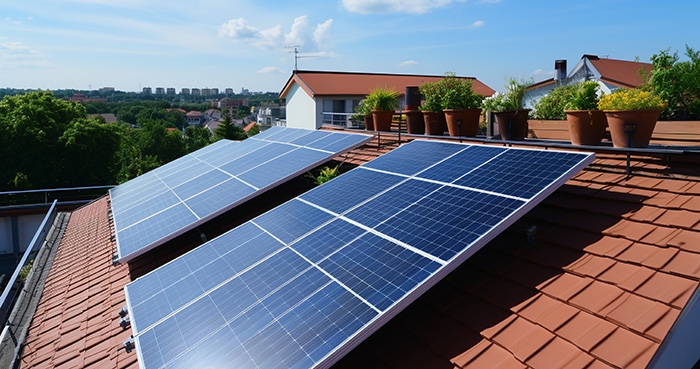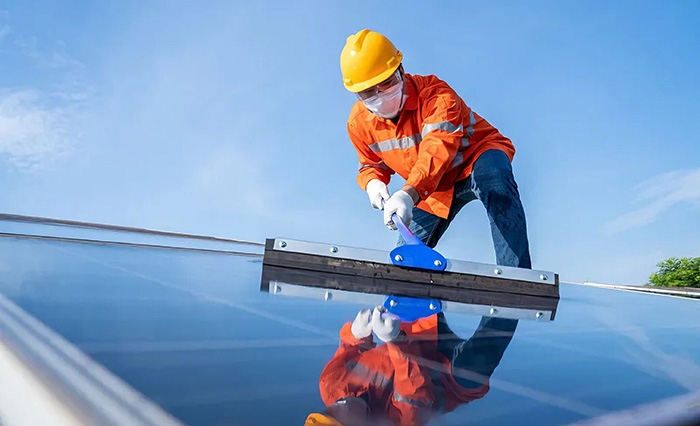With the growing global demand for energy and the expansion of clean energy applications, photovoltaic (PV) power stations have become a widely adopted solution for green and sustainable power production. However, achieving a stable and efficient power output from a PV power station involves multiple factors, from component selection and system configuration to operations and maintenance.
Today, Inverter Online Store will discuss how to maximize the power generation of a PV power station by focusing on key aspects, such as the efficiency of PV modules, the safety and efficiency of inverters, the rationalization of system configuration, methods for reducing power losses, and the necessity of regular maintenance.
PV Module Efficiency: The Core Foundation
PV modules are the core equipment in a PV power station, converting sunlight into electricity, and their efficiency directly impacts the station’s power generation capacity. Below are the major factors that affect PV module efficiency:
- Module Materials and Technology: The most common PV module materials on the market are monocrystalline silicon, polycrystalline silicon, and thin-film materials. Monocrystalline silicon modules offer the highest conversion efficiency, making them ideal for applications requiring high power output. Polycrystalline silicon modules are more cost-effective but slightly less efficient than monocrystalline modules. Emerging thin-film technologies, such as perovskite and cadmium telluride, are adaptable and inexpensive, but since these technologies are still maturing, their conversion efficiency and stability require further improvement.
- Temperature Coefficient: The temperature coefficient indicates the power loss of a module as temperature rises. As PV modules heat, their efficiency declines, which is particularly significant in hot climates. Therefore, choosing modules with a low-temperature coefficient is recommended to minimize efficiency loss.
- Light Absorption Capability: The anti-reflective coating and back sheet material of the module affect light absorption efficiency. High-quality anti-reflective coatings can improve light absorption under various sunlight conditions, and reflective backsheets help enhance overall efficiency. Advanced bifacial modules, which absorb light from both the front and back, are suitable for sunny locations, further boosting power output.
- Quality and Degradation Rate: The quality of a module impacts both performance and lifespan. High-quality PV modules have a low degradation rate, so they maintain high efficiency even after years of use. Choosing modules with a low degradation rate and a long warranty helps ensure steady power output over time.
By choosing high-efficiency, stable PV modules, you can ensure a high level of power output, laying a solid foundation for overall station performance.

Inverter Safety and Efficiency: The Key to Energy Conversion
Inverters are the core equipment that converts the direct current (DC) generated by PV modules into alternating current (AC), and their performance is crucial to the system’s safety and efficiency. Key factors that impact inverter performance include:
- Conversion Efficiency: A high-efficiency inverter maximizes the conversion of DC generated by PV modules into usable AC. When choosing an inverter, products with a conversion efficiency above 98% are recommended to minimize unnecessary power loss.
- Maximum Power Point Tracking (MPPT): MPPT technology in inverters can automatically adjust the input voltage based on sunlight intensity and temperature, ensuring that PV modules operate at the optimal power output point. This technology helps the system achieve maximum efficiency under different weather and lighting conditions.
- Thermal Management: Inverters generate significant heat during operation, and good thermal design prevents overheating, improving operational stability and lifespan. Proper thermal management also prevents conversion efficiency loss due to high temperatures, so installing inverters in well-ventilated areas is advisable.
- Safety and Protection Rating: The protection rating (IP rating) of an inverter is directly related to its stability in harsh environments, such as dusty or humid conditions. Choosing inverters with high protection ratings and features like over-voltage and short-circuit protection enhances system safety and long-term reliability.
A safe, efficient inverter not only improves overall system power generation efficiency but also ensures the long-term stable operation of a PV power station, making it one of the essential elements in boosting power output.
Standardized System Configuration: Ensuring Efficient Power Transmission
System configuration in PV power stations involves the arrangement of PV modules, connection methods, cable selection, and other aspects. Rational system design and configuration are prerequisites for efficient power generation. Key steps include:
- Module Array Design: The arrangement and angle of modules directly affect light absorption. An optimized array design ensures that the module surfaces receive maximum sunlight, improving power generation efficiency. It is essential to choose the best installation angle based on local latitude and sunlight conditions while avoiding mutual shading between modules.
- System Wiring Configuration: Different wiring methods (series or parallel) affect voltage and current output. Designing a suitable series-parallel structure based on actual needs can reduce line losses and maintain the optimal operating state for the inverter.
- Cable Selection and Layout: Cable quality and layout have a significant impact on overall energy consumption in PV systems. Choosing cables that are resistant to high temperatures and corrosion with low resistance helps reduce energy loss during transmission. Minimizing cable length also helps reduce power losses during transmission.
- Lightning Protection and Grounding: PV power stations are typically located outdoors, so effective lightning and grounding protection are necessary. These facilities protect the system from lightning strikes, ensuring safe and stable operation during extreme weather.
Standardized system configuration and scientific design effectively improve overall system efficiency and reduce power transmission losses, further enhancing power output.
Reducing Losses: Core of Energy Efficiency Management
Power loss is inevitable in PV power stations during energy conversion and transmission, so minimizing losses at each stage is crucial to maximizing overall power output. Key methods for reducing losses include:
- Avoiding Obstructions: Obstructions significantly reduce the power generation efficiency of PV modules, especially in series circuits where shading on one module can reduce the efficiency of the entire string. The installation location of the PV station should avoid obstructions such as trees and buildings to ensure maximum sunlight exposure for the modules.
- Reducing Shadow Effects: Using micro-inverters or optimizers can effectively reduce the impact of shading on the module array. These devices allow independent adjustment for each module, so shaded sections do not affect the power output of the entire system.
- Optimized Wiring: Power transmission inevitably results in heat losses due to resistance, so using low-resistance cables and optimizing the wiring layout by reducing cable length can help minimize energy loss.
- Regular Maintenance and Cleaning: Dust and debris, such as bird droppings, can accumulate on module surfaces, blocking sunlight and decreasing power output. Regular cleaning of PV module surfaces helps maintain high power output. Regular cleaning and maintenance are especially important in areas prone to dust storms.
Reducing energy losses in the system effectively increases the overall efficiency of the PV station and is a key strategy for achieving higher power output.

Routine Operations and Maintenance: The Foundation of Efficient Operation
The routine operations and maintenance of a PV power station directly impact system stability and power output. Effective maintenance strategies extend equipment lifespan and ensure continuous efficient operation.
- Real-Time System Monitoring: Intelligent monitoring systems enable real-time tracking of a PV station’s operating status, allowing for quick fault detection and resolution. For example, inverters, module performance, and power generation data can all be monitored in real-time, ensuring the system operates at optimal levels.
- Regular Inspections and Maintenance: Equipment such as inverters, cables, and grounding systems may deteriorate over time, so regular inspections can help identify and resolve issues before they lead to power losses due to equipment failure.
- PV Module Cleaning: Dust and leaves often accumulate on PV module surfaces, affecting power output. Regularly cleaning the modules ensures sufficient sunlight exposure. Cleaning is particularly important in areas with high dust levels or frequent rainfall.
- Temperature Management: PV systems operate less efficiently under high temperatures, especially inverters and modules. Therefore, installing them in well-ventilated locations and using cooling measures if necessary ensures the safety and stability of the equipment.
- Regular Updates and Upgrades: With advances in PV technology, new modules, and inverters offer increased efficiency. Regular system upgrades or replacement of outdated equipment can significantly improve overall power generation.
Effective routine maintenance ensures long-term stable operation of PV systems and is essential for maximizing power output.
Conclusion
Maximizing power output in a PV power station involves the comprehensive optimization of multiple factors. From selecting efficient PV modules and ensuring safe, efficient inverter operation to standardizing system configuration, reducing losses, and implementing scientific routine maintenance, each aspect directly affects the final power output. Increasing PV station output not only enhances the system’s economic return but also supports the broader adoption of clean energy. By understanding and optimizing each component of a PV power station, you can achieve higher power generation efficiency, meeting the growing demand for clean electricity. If you have any questions, please contact us and we will provide you with more detailed professional answers and support.
